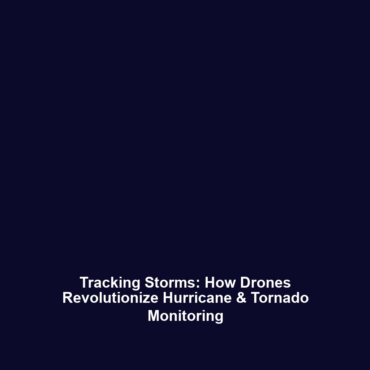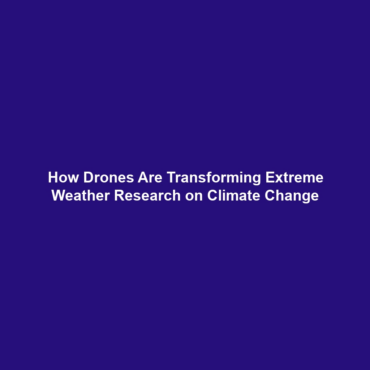The Role of Drones in Tracking Storm Systems, Hurricanes, and Tornadoes
In recent years, the integration of drones in science has revolutionized our approach to monitoring atmospheric phenomena. Drones have emerged as essential tools for tracking storm systems, hurricanes, and tornadoes, providing real-time data that enhances our understanding of severe weather events. Their ability to collect high-resolution environmental data allows scientists to develop more accurate forecasting models, ultimately improving emergency preparedness and response strategies.
Key Concepts
Understanding the role of drones in meteorology involves several key concepts:
- Aerial Surveillance: Drones can fly into severe weather systems, collecting data from areas previously unreachable without risking human lives.
- Data Collection: Equipped with sensors and cameras, drones gather vital meteorological data such as temperature, humidity, wind speed, and atmospheric pressure.
- Real-time Analysis: The ability to transmit data instantaneously allows for immediate analysis and quicker response times during severe weather events.
These concepts demonstrate how the use of drones fits into the broader category of drones in science by enhancing our capabilities in meteorological research and storm tracking.
Applications and Real-World Uses
The application of drones in tracking storm systems, hurricanes, and tornadoes is multifaceted and impactful:
- Hurricane Monitoring: Drones are deployed to monitor hurricanes from within, providing critical information about storm intensity and structure.
- Tornado Research: Researchers use drones to examine tornado formation and behavior, gaining insights into how these phenomena develop and dissipate.
- Disaster Response: After storm events, drones assist in damage assessment and recovery efforts, providing real-time aerial imagery to emergency response teams.
These practical uses illustrate how drones are facilitating advancements in storm tracking and are pivotal in the category of drones in science.
Current Challenges
Despite their promising applications, there are significant challenges in using drones for storm tracking:
- Regulatory Issues: Navigating airspace regulations can hinder the deployment of drones during critical events.
- Technical Limitations: Battery life and payload capacity remain constraints that affect operational range and data collection capabilities.
- Data Interpretation: The vast amount of data collected requires sophisticated analysis tools to derive meaningful insights.
Addressing these challenges is imperative for maximizing the potential of drones in meteorological science.
Future Research and Innovations
The future of drones in tracking storm systems, hurricanes, and tornadoes is filled with potential innovations:
- Autonomous Flight: Advances in AI and machine learning may allow drones to operate autonomously in challenging weather conditions.
- Improved Sensors: Next-generation sensors capable of capturing higher resolution data will enhance the quality of information collected.
- Swarm Technology: Implementing drone swarms could provide comprehensive data coverage and improved storm monitoring capabilities.
These innovations signal a transformative shift in how meteorological research and storm tracking can evolve with emerging drone technologies.
Conclusion
The role of drones in tracking storm systems, hurricanes, and tornadoes is undeniably vital within the field of drones in science. As these technologies advance, they will significantly enhance our understanding of severe weather and improve disaster response capabilities. Ongoing research and innovation will be crucial in overcoming current challenges and maximizing the benefits of drones for societal safety and scientific advancement. For further insights, explore our related articles on drones and climate research and meteorological advancements.

